Effect of Irradiated and Non-Irradiated Waste PET Based Cementitious Grouts on Flexural Strength of Semi-Flexible Pavement
Abstract
1. Introduction
1.1. Water–Cement Ratio
1.2. Admixtures, By-Products and Other Supplementary Materials
1.3. Voids in Porous Asphalt Mixtures
1.4. Bitumen Type and Aggregate Gradation
2. Materials and Methods
2.1. Material Selection
2.2. Preparation of Grouts
2.3. Mix Design of Porous Asphalt Skeleton
2.4. Preparation of Semi-Flexible Specimens
2.5. Flexural Test of Beam Specimen
3. Results and Discussions
3.1. Flow and Compressive Strength of Initial Grouts
3.2. Flexural Strength of Semi-Flexible Specimens
3.2.1. OPC Based Semi-Flexible Beams
3.2.2. GPC Based Semi-Flexible Beams
4. Conclusions
- Addition of superplasticizer (1% by weight of cement) increases the fluidity of grouts, which allows cementitious grouts to fully penetrate through the porous asphalt skeleton.
- Replacement of cement with waste PET in cementitious grout for semi-flexible specimens showed similar flexural strength properties at 1-day and 28-days curing in comparison to the control mixtures.
- The strength gained by PET based grouts at 28-days curing is more than 60% higher than 1-day curing, while the increase was 50% for the control specimens. The results implied that strength gained in PET based grouts were more than that of control mix.
- Normal PET based GPC grouts showed 9–10% increase in flexural strength of semi-flexible specimens as compared to control samples.
- There is reduction in flexural strength of irradiated PET based GPC grouts by 22–23% and 13–14% as compared to normal PET and control samples respectively.
- The utilization of waste plastic and fly-ash as a cement replacement can have a positive impact on the environment in terms of recycling plastic wastes and industry by-products in pavement construction.
Author Contributions
Funding
Acknowledgments
Conflicts of Interest
References
- Koting, S.; Karim, M.R.; Mahmud, H.B.; Hamid, A.; Anjang, N. Mechanical Properties of Cement-Bitumen Composites for Semi-Flexible Pavement Surfacing. Balt. J. Road Bridge Eng. 2014, 9, 191–199. [Google Scholar] [CrossRef]
- Oliveira, J.R.; Pais, J.C.; Thom, N.H.; Zoorob, S.E. A Study of the Fatigue Properties of Grouted Macadams. Int. J. Pavements 2007, 6, 112–123. [Google Scholar]
- Pratelli, C.; Betti, G.; Giuffrè, T.; Marradi, A. Preliminary In-Situ Evaluation of an Innovative, Semi-Flexible Pavement Wearing Course Mixture Using Fast Falling Weight Deflectometer. Materials 2018, 11, 611. [Google Scholar] [CrossRef]
- Karami, M. Application of the cementitious grouts on stability and durability of semi flexible bituminous mixtures. In AIP Conference Proceedings; AIP Publishing: Melville, NY, USA, 2017; Volume 1903, p. 020012. [Google Scholar]
- Ahlrich, R.C.; Anderton, L.G. Construction and Evaluation of Resin Modified Pavement. Army Engineer Waterways Experiment Station Vicksburg MS Geotechnical Lab. Technical Report: GL-91-13. Available online: https://apps.dtic.mil/docs/citations/ADA2398721991 (accessed on 30 December 2018).
- Pei, J.; Cai, J.; Zou, D.; Zhang, J.; Li, R.; Chen, X.; Jin, L. Design and performance validation of high-performance cement paste as a grouting material for semi-flexible pavement. Constr. Build. Mater. 2016, 126, 206–217. [Google Scholar] [CrossRef]
- Bang, J.W.; Lee, B.J.; Kim, Y.Y. Development of a Semirigid Pavement Incorporating Ultrarapid Hardening Cement and Chemical Admixtures for Cement Grouts. Adv. Mater. Sci. Eng. 2017, 2017. [Google Scholar] [CrossRef]
- Ahmedzade, P.; Fainleib, A.; Günay, T.; Starostenko, O.; Kovalinska, T. Effect of gamma-irradiated recycled low-density polyethylene on the high-and low-temperature properties of Bitumen. Int. J. Polym. Sci. 2013, 2013. [Google Scholar] [CrossRef]
- Martínez-Barrera, G.; Menchaca-Campos, C.; Hernández-López, S.; Vigueras-Santiago, E.; Brostow, W. Concrete Reinforced with Irradiated Nylon Fibers. J. Mater. Res. 2006, 21, 484–491. [Google Scholar] [CrossRef]
- Wang, D.; Liang, X.; Jiang, C.; Pan, Y. Impact analysis of Carboxyl Latex on the performance of semi-flexible pavement using warm-mix technology. Constr. Build. Mater. 2018, 179, 566–575. [Google Scholar] [CrossRef]
- Huang, C.; Hong, J.X.; Lin, J.T.; Deng, C.; Li, L. Utilization of waste rubber powder in semi-flexible pavement. Key Eng. Mater. 2014, 599, 361–367. [Google Scholar] [CrossRef]
- Zhang, J.; Cai, J.; Pei, J.; Li, R.; Chen, X. Formulation and performance comparison of grouting materials for semi-flexible pavement. Constr. Build. Mater. 2016, 115, 582–592. [Google Scholar] [CrossRef]
- Afonso, M.L.; Dinis-Almeida, M.; Pereira-de-Oliveira, L.A.; Castro-Gomes, J.; Zoorob, S.E. Development of a semi-flexible heavy duty pavement surfacing incorporating recycled and waste aggregates—Preliminary study. Constr. Build. Mater. 2016, 102, 155–161. [Google Scholar] [CrossRef]
- Oliveira, J.R. Grouted Macadam: Material Characterisation for Pavement Design. Ph.D. Thesis, University of Nottingham, Nottingham, UK, 2006. [Google Scholar]
- Anderton, G.L. User’s Guide: Resin Modified Pavement. Army Engineer Waterways Experiment Station Vicksburg MS Geotechnical Lab., No. WES/MP/GL-96-7. 1996. Available online: https://apps.dtic.mil/docs/citations/ADA307526 (accessed on 20 December 2018).
- Pham, P.N.; Zhuge, Y.; Turatsinze, A.; Toumi, A.; Siddique, R. Application of rubberized cement-based composites in pavements: Suitability and considerations. Constr. Build. Mater. 2019, 223, 1182–1195. [Google Scholar] [CrossRef]
- Cai, J.; Pei, J.; Luo, Q.; Zhang, J.; Li, R.; Chen, X. Comprehensive service properties evaluation of composite grouting materials with high-performance cement paste for semi-flexible pavement. Constr. Build. Mater. 2017, 153, 544–556. [Google Scholar] [CrossRef]
- Gong, M.; Xiong, Z.; Chen, H.; Deng, C.; Chen, X.; Yang, J.; Zhu, H.; Hong, J. Evaluation on the cracking resistance of semi-flexible pavement mixture by laboratory research and field validation. Constr. Build. Mater. 2019, 207, 387–395. [Google Scholar] [CrossRef]
- Luo, S.; Yang, X.; Zhong, K.; Yin, J. Open-graded asphalt concrete grouted by latex modified cement mortar. Road Mater. Pavement Des. 2018, 1–17. [Google Scholar] [CrossRef]
- Plug, P.C.; de Bondt, A.H.; van der Woerd, B.J.; Steensma, G. Improved Performance Grouted Macadams—High Performance Applications of Grouted Macadam. Available online: http://www.materialedge.co.uk/docs/CP-AdB-Stabifalt(English)[1].pdf (accessed on 20 December 2018).
- Yang, B.; Weng, X.J.C.; Materials, B. The influence on the durability of semi-flexible airport pavement materials to cyclic wheel load test. Constr. Build. Mater. 2015, 98, 171–175. [Google Scholar] [CrossRef]
- Husain, N.M.; Mahmud, H.; Karim, M.R.; Hamid, N. Effects of aggregate gradations on properties of grouted Macadam composite pavement. In Proceedings of the 2010 2nd International Conference on Chemical, Biological and Environmental Engineering (ICBEE), Cairo, Egypt, 2–4 November 2010; IEEE: Piscataway, NJ, USA, 2010; pp. 128–131. [Google Scholar]
- Husain, N.M.; Karim, M.R.; Mahmud, H.B.; Koting, S. Effects of Aggregate Gradation on the Physical Properties of Semiflexible Pavement. Adv. Mater. Sci. Eng. 2014, 2014. [Google Scholar] [CrossRef]
- National Solid Waste Management Department Survey on Solid Waste Composition, Characteristics & Existing Practice of Solid Waste Recycling in Malaysia. Available online: https://jpspn.kpkt.gov.my/resources/index/user_1/Sumber_Rujukan/kajian/Final_Report_REVz.pdf. (accessed on 20 December 2018).
- Waste and Resources Action Programme (WRAP). Annual Local Authorities Plastics Collection Survey; Waste and Resources Action Programme (WRAP): Banbury, UK, 2007. [Google Scholar]
- Road Engineering Association of Malaysia (REAM). Road Engineering Association of Malaysia, Speciication of Semi-Rigid Wearing Course; Road Engineering Association of Malaysia (REAM): Shah Alam, Malaysia, 2007. [Google Scholar]
- Schaefer, C.E.; Kupwade-Patil, K.; Ortega, M.; Soriano, C.; Büyüköztürk, O.; White, A.E.; Short, M.P. Irradiated recycled plastic as a concrete additive for improved chemo-mechanical properties and lower carbon footprint. Waste Manag. 2018, 71, 426–439. [Google Scholar] [CrossRef] [PubMed]
- ASTMC-305-14. Standard Practice for Mechanical Mixing of Hydraulic Cement Pastes and Mortars of Plastic Consistency; ASTM International: West Conshohocken, PA, USA, 2003. [Google Scholar]
- Zahid, M.; Shafiq, N.; Jalal, A. Investigating the effects of solarcure curing method on the compressive strength, microstructure and polymeric reaction of fly ash based geopolymer. Constr. Build. Mater. 2018, 181, 227–237. [Google Scholar] [CrossRef]
- Public Works Department Description of Workmanship and Materials (Semi-Rigid Pavement), Section E; City Hall Kuala Lumpur: Kuala Lumpur, Malaysia, 2003.
- ASTM-C109. Standard Test Method for Compressive Strength of Hydraulic Cement Mortars; ASTM International: West Conshohocken, PA, USA, 2008. [Google Scholar]
- ASTM-D6926-16. Standard Practice for Preparation of Asphalt Mixture Specimens Using Marshall Apparatus; ASTM International: West Conshohocken, PA, USA, 2016. [Google Scholar]
- ASTM-D6927-15. Standard Test Method for Marshall Stability and Flow of Asphalt Mixtures; ASTM International: West Conshohocken, PA, USA, 2015. [Google Scholar]
- ASTM-C293. Standard Test Method for Flexural Strength of Concrete (Using Simple Beam with Center-Point Loading); ASTM: Philadelphia, PA, USA, 2001. [Google Scholar]

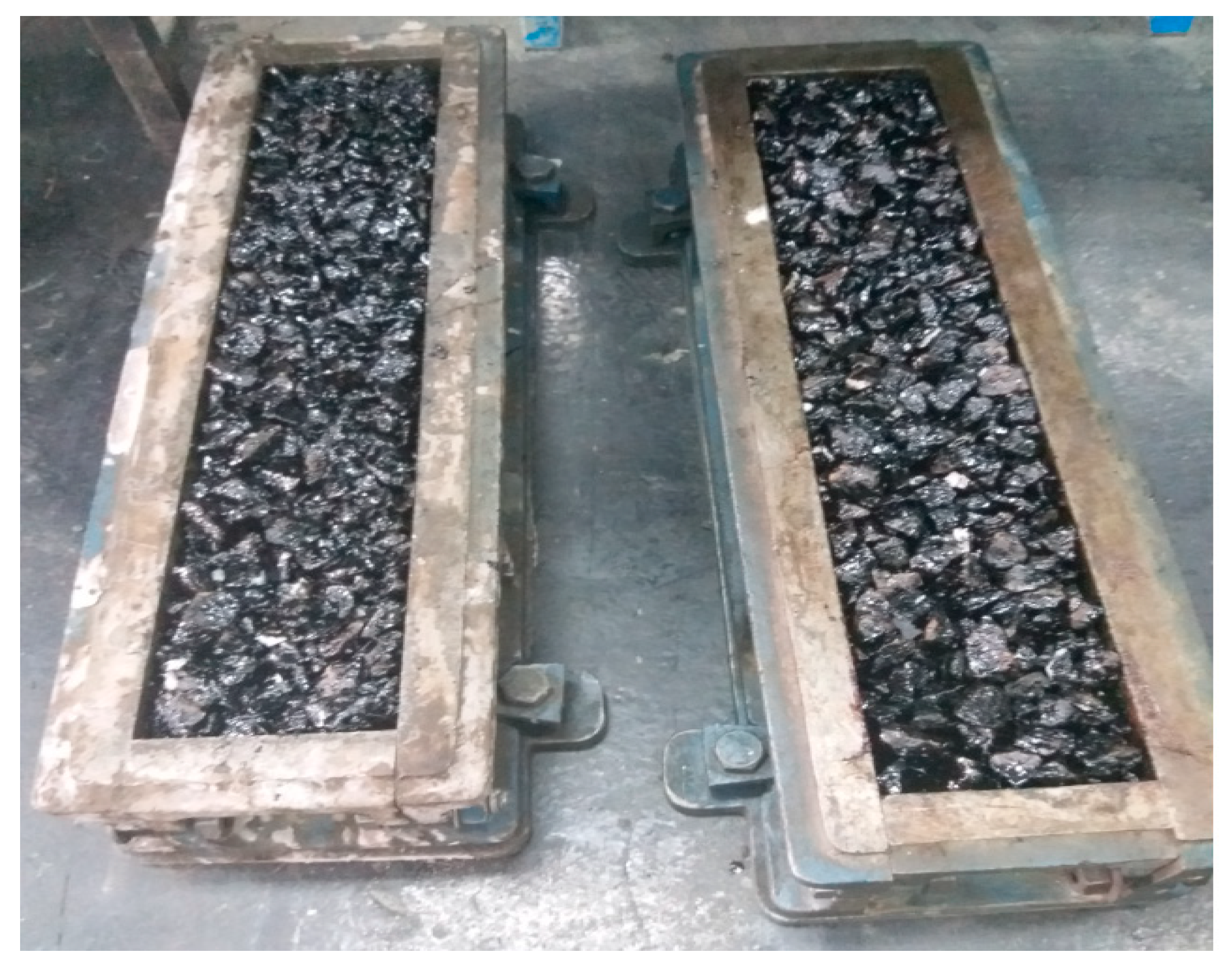

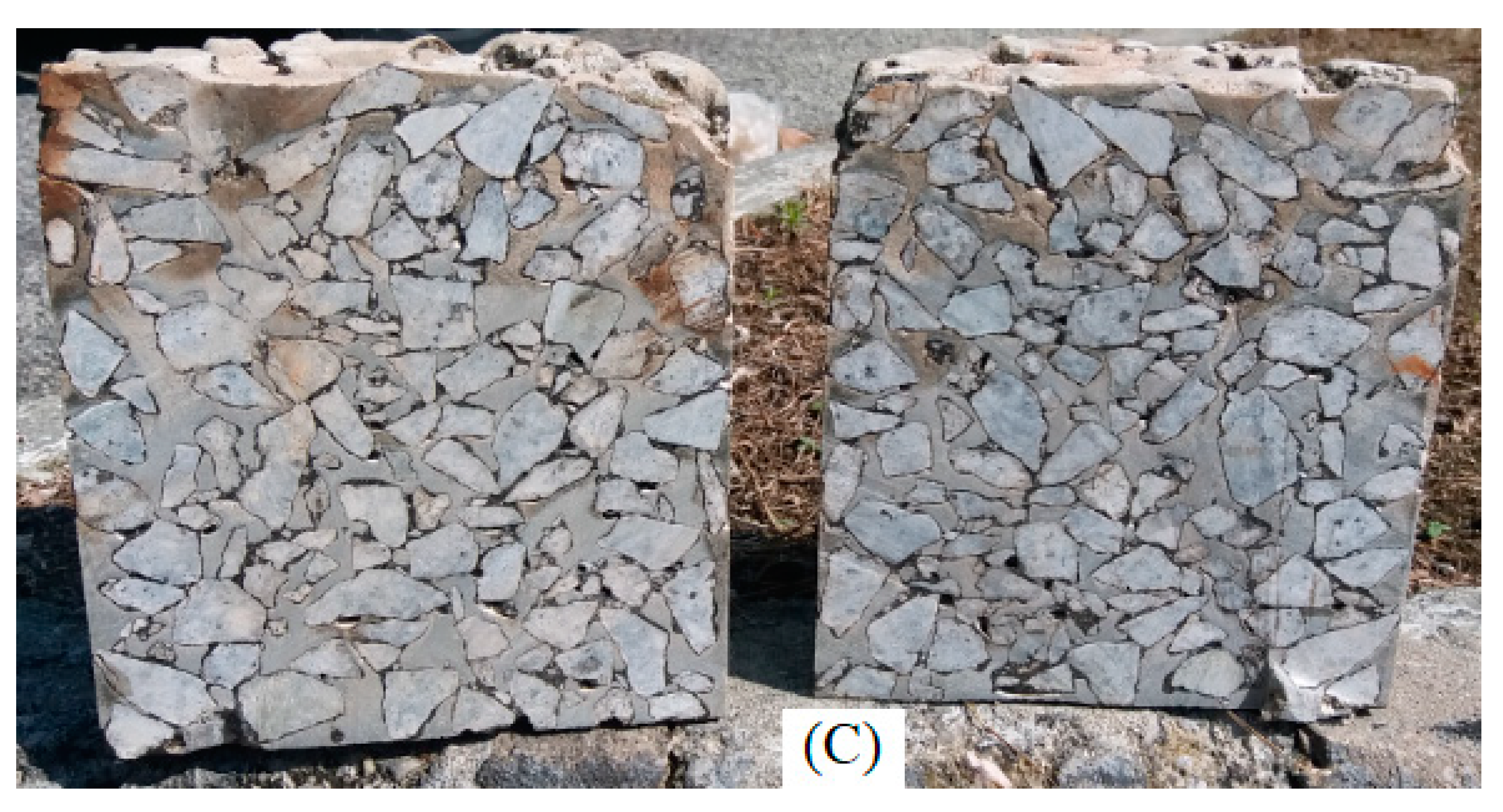
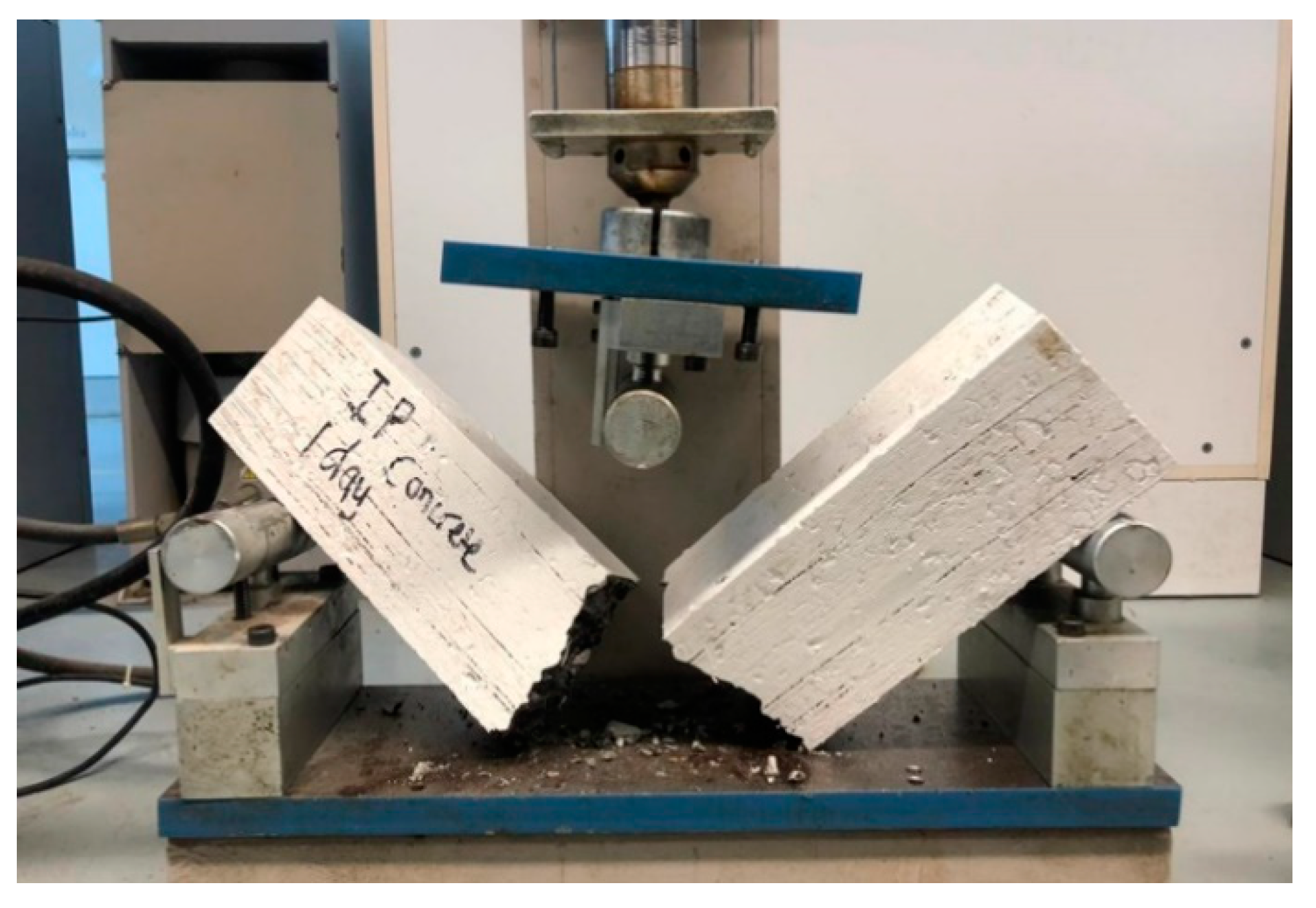

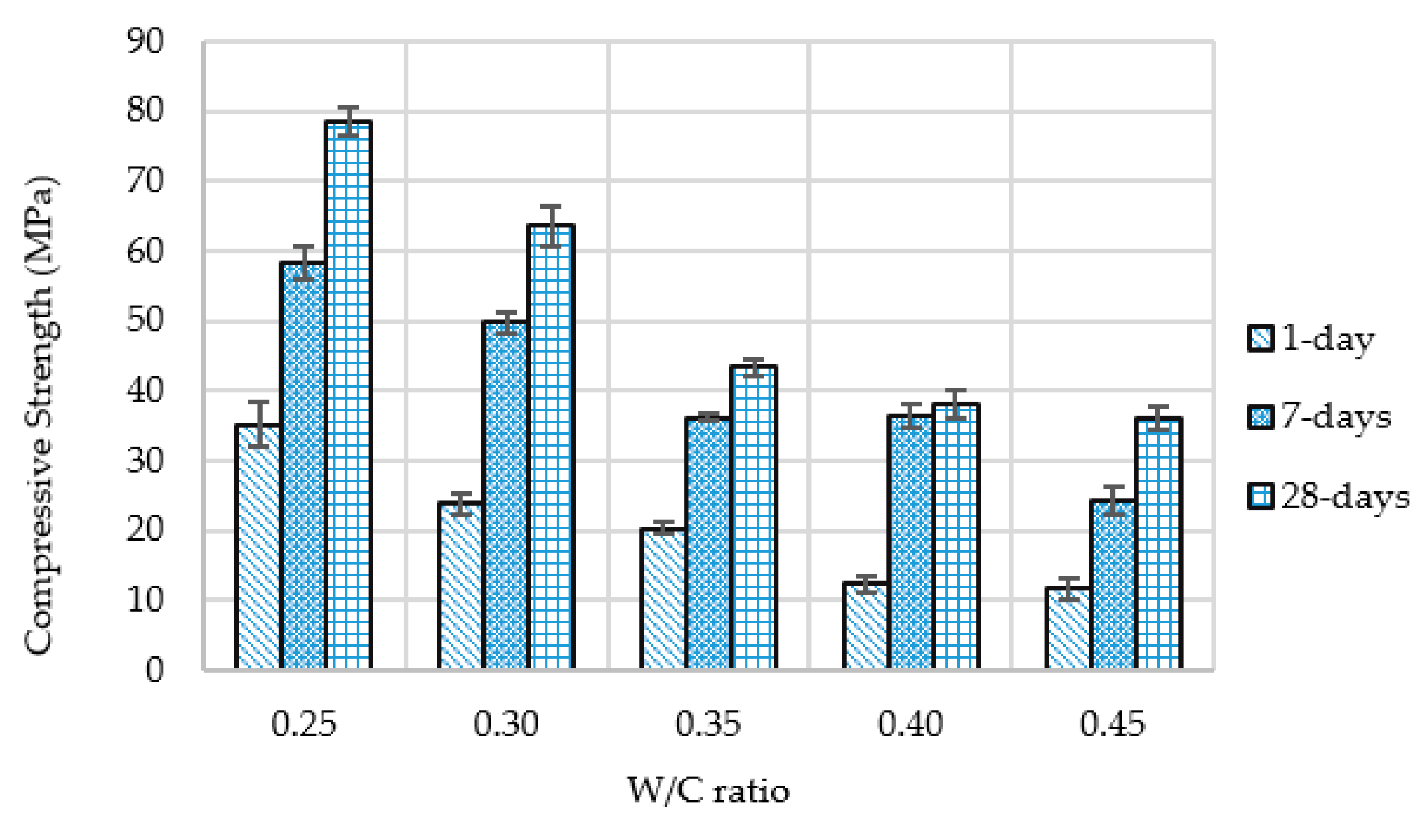
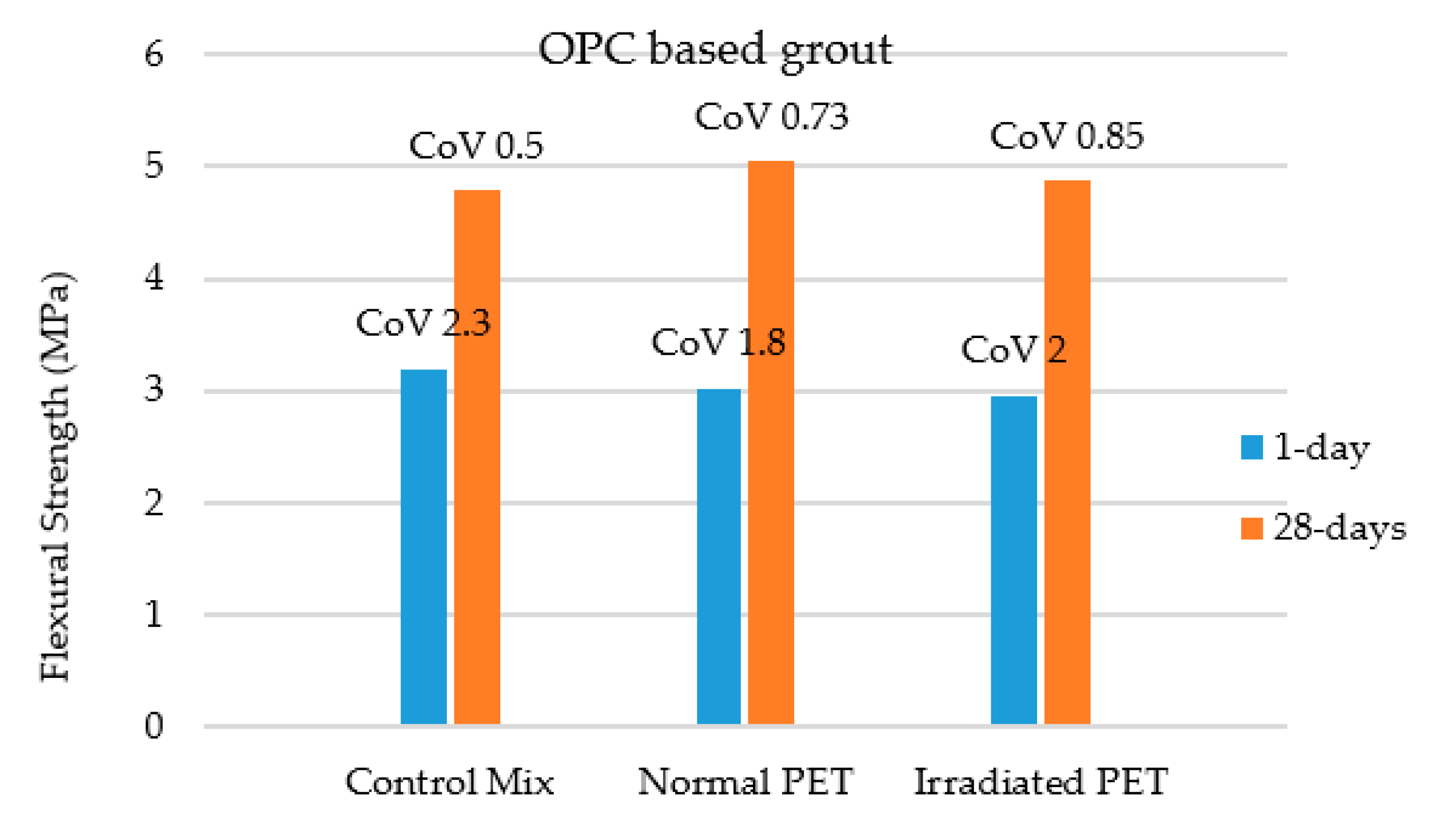
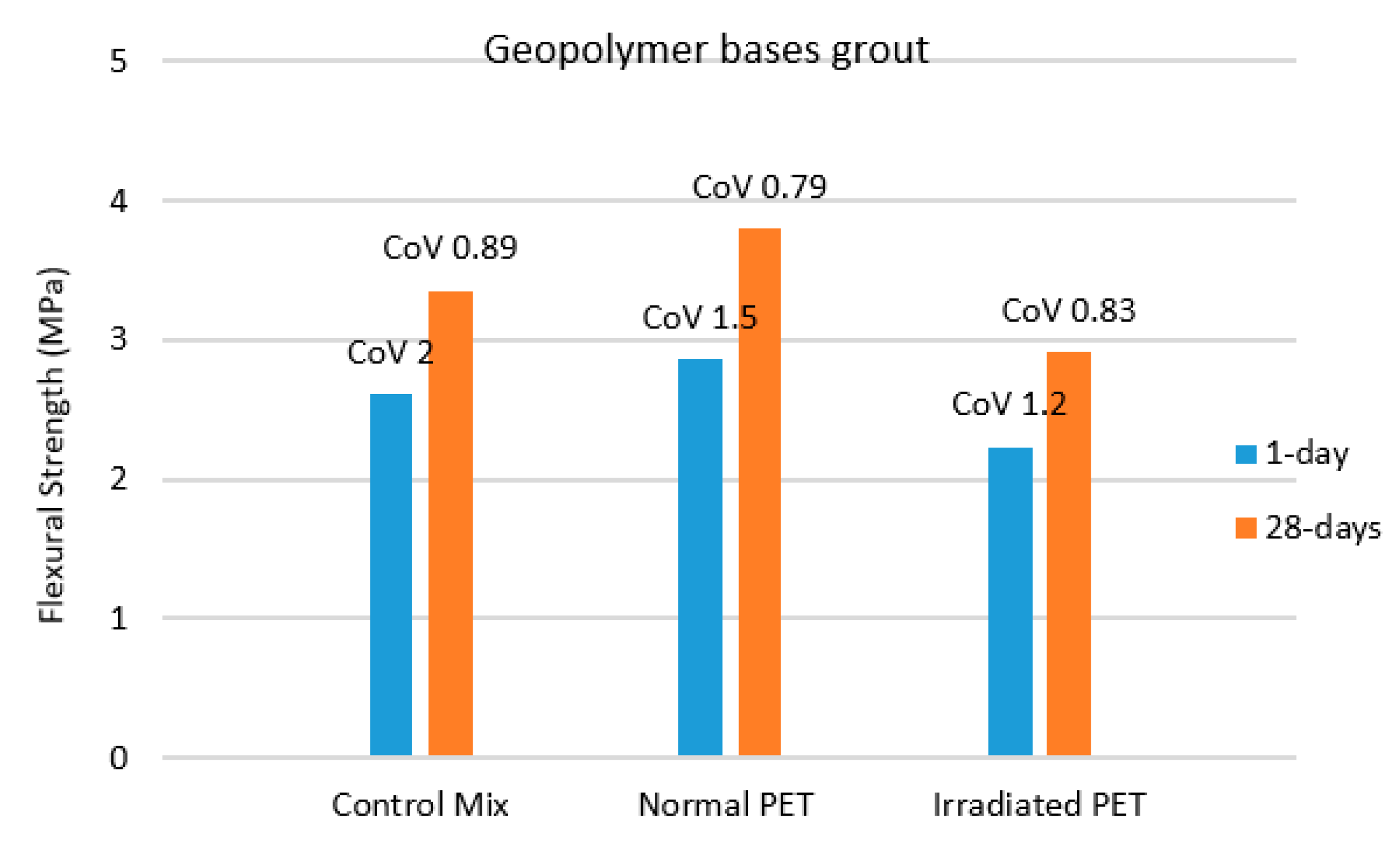
| Mix Composition for Porous Asphalt Structure [26] | Compositions of Grouts | |||
|---|---|---|---|---|
| Composition | Weight (%) | OPC based Grouts | GPC based Grouts | |
| Bitumen | 3.0–4.0% | w/c ratio | 0.35 | Na2SiO3:NaOH (3:1) |
| Filler (OPC) | 4.0% | Superplasticizer | 1% by weight of OPC | NaOH:H2O (32:100) |
| Aggregate | 92–93% | |||
| Voids content | 20–30% | PET (Irradiated and Non-Irradiated) | 1.25% by weight of OPC | Superplasticizer (1% by Fly-Ash) |
| Material/ | SiO2 | Al2O3 | Fe2O3 | CaO | MgO | K2O | SO3 | TiO2 | P2O5 | Na2O | Others |
|---|---|---|---|---|---|---|---|---|---|---|---|
| Cement | 22.65 | 4.63 | 2.34 | 61.72 | 4.23 | 1.14 | 2.24 | 0.20 | 0.12 | 0.11 | 0.62 |
| Fly Ash | 36.4 | 13.72 | 18.24 | 19 | 3.26 | 2.2 | 2.5 | 1.45 | 1.2 | 1.73 | 0.3 |
| 1-day Curing | |||
| Control Mix | Normal PET | Irradiated PET | |
| Mean | 3.19 | 3.01 | 2.95 |
| Variance | 2.28 | 1.89 | 2 |
| P(T ≤ t) one-tail | 0.4 | 0.06 | 0.37 |
| t Critical one-tail | 2.91 | 2.91 | 2.91 |
| P(T ≤ t) two-tail | 0.81 | 0.12 | 0.75 |
| t Critical two-tail | 4.3 | 4.3 | 4.3 |
| 28-days Curing | |||
| Control Mix | Normal PET | Irradiated PET | |
| Mean | 4.78 | 5.04 | 4.86 |
| Variance | 0.47 | 0.73 | 0.84 |
| P(T ≤ t) one-tail | 0.38 | 0.42 | 0.46 |
| t Critical one-tail | 2.91 | 2.91 | 2.91 |
| P(T ≤ t) two-tail | 0.76 | 0.84 | 0.93 |
| t Critical two-tail | 4.3 | 4.3 | 4.3 |
| 1-day Curing | |||
| Control Mix | Normal PET | Irradiated PET | |
| Mean | 2.61 | 2.86 | 2.23 |
| Variance | 2 | 1.5 | 1.2 |
| P(T ≤ t) one-tail | 0.0006 | 0.001 | 0.005 |
| t Critical one-tail | 2.91 | 2.91 | 2.91 |
| P(T ≤ t) two-tail | 0.0012 | 0.003 | 0.011 |
| t Critical two-tail | 4.3 | 4.3 | 4.3 |
| 28-days Curing | |||
| Control Mix | Normal PET | Irradiated PET | |
| Mean | 3.35 | 3.79 | 2.91 |
| Variance | 0.89 | 0.79 | 0.83 |
| P(T ≤ t) one-tail | 0.00034 | 0.00005 | 0.0003 |
| t Critical one-tail | 2.91 | 2.91 | 2.91 |
| P(T ≤ t) two-tail | 0.0002 | 0.0001 | 0.0006 |
| t Critical two-tail | 4.3 | 4.3 | 4.3 |
© 2019 by the authors. Licensee MDPI, Basel, Switzerland. This article is an open access article distributed under the terms and conditions of the Creative Commons Attribution (CC BY) license (http://creativecommons.org/licenses/by/4.0/).
Share and Cite
Khan, M.I.; Huat, H.Y.; Dun, M.H.b.M.; Sutanto, M.H.; Jarghouyeh, E.N.; Zoorob, S.E. Effect of Irradiated and Non-Irradiated Waste PET Based Cementitious Grouts on Flexural Strength of Semi-Flexible Pavement. Materials 2019, 12, 4133. https://doi.org/10.3390/ma12244133
Khan MI, Huat HY, Dun MHbM, Sutanto MH, Jarghouyeh EN, Zoorob SE. Effect of Irradiated and Non-Irradiated Waste PET Based Cementitious Grouts on Flexural Strength of Semi-Flexible Pavement. Materials. 2019; 12(24):4133. https://doi.org/10.3390/ma12244133
Chicago/Turabian StyleKhan, Muhammad Imran, Huang Yong Huat, Mohammad Haziq bin Muhamad Dun, Muslich Hartadi Sutanto, Ehsan Nikbakht Jarghouyeh, and Salah E. Zoorob. 2019. "Effect of Irradiated and Non-Irradiated Waste PET Based Cementitious Grouts on Flexural Strength of Semi-Flexible Pavement" Materials 12, no. 24: 4133. https://doi.org/10.3390/ma12244133
APA StyleKhan, M. I., Huat, H. Y., Dun, M. H. b. M., Sutanto, M. H., Jarghouyeh, E. N., & Zoorob, S. E. (2019). Effect of Irradiated and Non-Irradiated Waste PET Based Cementitious Grouts on Flexural Strength of Semi-Flexible Pavement. Materials, 12(24), 4133. https://doi.org/10.3390/ma12244133





